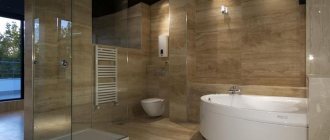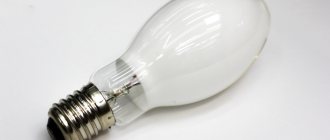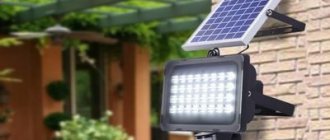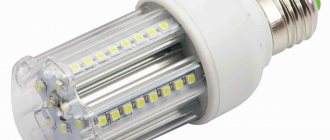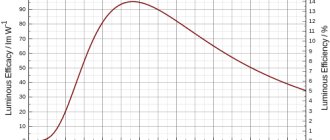Choosing LED lamps for outdoor lighting
LED street lighting fixtures have recently become increasingly popular. This is not surprising because they are quite economical, have a large selection of modifications and colors.
Such lighting can safely be called modern. That is why we also decided to pay attention to this issue and analyze the aspects associated with the process of selecting and installing such lamps.
No. 1. Main advantages and disadvantages
Let's start with a few words about the operating principle of outdoor LED lamps. In fact, these are independent devices, the housing of which is unique and usually designed for a specific LED lighting source. Any such lamp consists of a base, a metal case with vertical ribs for effective heat dissipation, a board with LEDs, a translucent hemisphere and a power converter, which is also called an electronic driver. The body is coated with protective paint. The operation is based on the principle of emission of light waves, which occurs as a result of an electrical impulse. Luminaires designed in this way are highly energy efficient. It is advisable to place street lamps at a height of 4-11 m above ground level.
Advantages:
- low energy consumption;
- high durability. On average, a lamp of this kind is designed for a minimum of 50,000 hours of operation;
- unlimited resource of switching on and off;
- structural strength and a high level of protection from external negative environmental conditions, which is due to the structural features of the hull;
- wide range of operating temperatures (-40…+450С), which allows the use of LED lamps in any climatic conditions;
- comfort of the glow, because the lighting is contrasting, does not flicker, the devices themselves turn on and operate silently, and the quality of color rendering is excellent, which is especially important for lighting routes;
- no heating and the ability to adjust the brightness of the light;
- no harmful impact on the environment, because such lamps do not contain mercury and other toxic substances, so special conditions for their disposal will not be required;
- ease of installation.
Flaws:
- the high price, which discourages the purchase of LED lamps. It is worth carrying out minimal calculations in order to understand that in 2-3 years such a purchase will fully pay for itself, and the remaining 15-20 years of operation will allow you to save significant amounts of money on electricity bills;
- sensitivity to high temperatures, so they cannot be used in baths, saunas and near heat sources;
- Over time, you can observe a decrease in the brightness of the light, but this directly depends on the quality of the heat sink, so it is better to trust only products from trusted manufacturers.
Until recently, some complained about white light, which is not very comfortable for the eyes, but today almost all manufacturers produce LEDs, the light of which is completely adapted to the characteristics of our vision. We can again advise you to pay attention only to the products of trusted companies, but we’ll talk about the largest manufacturers further.
Some disadvantages of LED street products
LED lamps (for example, e27 or any others), despite an impressive list of advantages, have some disadvantages, which include:
- high cost of production. Whatever one may say, these are the most expensive light sources today;
Note! The purchase of LED products, despite the high cost, will quickly pay for itself with reduced electricity bills.
- characterized by thermal degradation. A special LED substrate acts as a heat sink. But at high air temperatures, such light bulbs begin to work less efficiently;
- sensitivity to voltage changes. These are low-voltage light sources that operate through special converters (power supply). You need to know this aspect when deciding to install LED strips on your summer cottage.
LED strips
In order for your outdoor LED lamp to work for a long time and efficiently, you must correctly install it on a pole or hang it on the facade of a building.
No. 2. LED lamps by purpose
Since the lighting requirements for different types of sites differ, manufacturers offer us LED lamps for various purposes:
- lighting _ Designed to illuminate open areas, sidewalks, roads, courtyards;
- architectural _ Used for decorative lighting of building facades, monuments and other objects that need to be emphasized;
- landscape. They are used to illuminate trees and parklands and are widely used in summer cottages.
No. 3. LED lamps by functionality
The principle of operation of an LED lamp described above is typical for typical spotlights and lanterns, but LEDs can also be used in the form of decorative lighting in duralight, duraflex and mesh. Therefore, it is customary to divide LED lamps into the following groups depending on functionality:
- spotlights are used to illuminate more or less large areas. Large floodlights illuminate roads, sports complexes, building facades; smaller lamps of this type are used in country and suburban areas to illuminate the territory and garden paths;
- lanterns provide diffused light and are used to illuminate sidewalks, garden plots, squares and other areas;
- duralight – a transparent tube with many LEDs inside, the distance between which is 1.5-27.5 mm. It is used for decorative contour lighting of buildings, as well as in landscape design to decorate trees. Some lamps of this type can give a constant glow, others - dynamic;
- Duraflex is characterized by increased resistance to moisture and high flexibility, so it can even be used to decorate areas around the pool and other bodies of water;
- ruler It looks like a flexible plastic strip onto which LEDs are attached in a vertical position. Used to decorate buildings, sometimes in advertising signs;
- The mesh is a network in which LEDs are attached to the nodes. It is stretched between supports, thus decorating the facades of buildings.
Classification of console lamps
Depending on the type of light source used, console devices are divided into three main types:
- LED – DKU;
- mercury - RKU;
- sodium - HCI.
All abbreviations contain encrypted basic information on lamps - type, model, purpose:
- K – console;
- U – street;
- D – LEDs;
- F – arc-type sodium lamp;
- R – mercury lamp.
LCS and RCS consume a large amount of energy (it is less than when operating lamps with filament), therefore, recently they are increasingly being replaced with energy-efficient LED designs. One of the most common models of these devices is “Cobra-150”.
No. 4. LED lamps by emission color
LED street lights can emit light of different colors, but the most popular color is white, which is the most difficult to obtain. Today, there are several of the most common technologies for achieving white light:
- RGB technology involves the use of blue, green and red LEDs in the substrate. For each, such a value of the transmitted current is selected so that the total radiation has the required color. The radiation is mixed using an optical system. The plus of the technology is the power of the light ceiling, the minus is the property of light to “float” over time. Using this technology, it is easy to obtain light of almost any shade and even dynamic lighting;
- technology of mixing the radiation of three phosphors (red, blue and green), which are excited when exposed to ultraviolet radiation from an LED. Such lamps are cheaper than others, but break down relatively quickly;
- technology of applying yellow phosphor to a blue LED.
No. 5. LED lamp protection class
The body of an LED lamp, as a rule, is quite strong and resistant to negative environmental influences, but still the level of protection can be different, and it must be selected based on the expected operating conditions. Each luminaire is characterized by a certain class, which is based on the standard for protecting electrical equipment from external factors IEC-952 .
Studying the table, we conclude that for installation on the territory of a personal plot it is better to choose a lamp with protection class IP 64 , and for lighting the area near the pool it is better to choose IP66.
Installation priority for console versions
The effective operation of a console lighting device for outdoor use can only be guaranteed if a number of recommendations and requirements are strictly observed. We list the main ones:
- a high level of safety, which is possible with high-quality protection of electrical wiring, increased strength and tightness of the housing, preventing the ingress of dust, moisture and precipitation (which could cause a short circuit);
- functionality - full compliance with the necessary technical and operational parameters, including power, color temperature, luminous flux;
- maximum ease of maintenance - if necessary, operating personnel must have timely access to the light source;
- the built-in diffuser must have high strength and be resistant to temperature changes and mechanical stress;
- Cost-effectiveness is one of the main features due to which city services choose LED products.
The cantilever design of LED luminaires provides several clear advantages to the device:
- chrome reflector increases efficiency up to 95%;
- the body is highly durable;
- complete tightness and high-quality protection from dust and moisture;
- resistance to vibrations that constantly affect devices placed on bridges or overpasses;
- resistance to corrosion formation.
Cantilever type LED luminaires satisfy all the requirements described above. Look out the window of an apartment or house, walk around the city and notice that such lighting devices are used to illuminate streets, pedestrian paths, main and adjacent highways, pedestrian crossings and other important elements. A more specific application is the local area of the private sector.
To conclude the topic about the advantages of the product, it should be noted that it is multi-tasking: the cantilever mount implies installation both on a special supporting structure and on the walls of the building and other vertical planes. In some cases, hanging installation is possible.
No. 6. Power and luminous flux
Different areas require different levels of illumination. When planning a lighting system for particularly critical areas (highways, stadiums, etc.), serious work is carried out to calculate the required luminous flux, the number of lamps and their luminous efficiency. Surface illumination is measured in lux (lx) using a special device - a lux meter. For example, the full moon in clear weather provides an illumination of 0.2 lux, but for painstaking jewelry work, illumination of 300 lux is sufficient. To understand what level of illumination is needed in each specific case, you can be guided by SNiP 05/23/2010 “Natural and artificial lighting”, which sets out the requirements for different objects. For example, for pedestrian streets it is 6 lux, for children’s playgrounds – 10 lux, and for utility areas – 2 lux. Accordingly, street LED lighting should provide the specified level, but it is better to immediately take lamps with a reserve, since over time the luminous flux still decreases.
Closely related to the concept of illumination is the amount of luminous flux , expressed in lumens (lm). This is the amount of luminous power that a light source emits. The higher the luminous flux, the higher the level of illumination of the territory - these values are proportionally dependent. The illumination on an object with an area of 1 m2 when a luminous flux of 1 lm falls on it will be equal to 1 lux. When moving away from the light source, the illumination level decreases in inverse proportion to the square of the distance: if at a distance of 1 m from the lamp the illumination is 900 lux, then at a distance of 2 m the illumination will decrease by 4 times, and at a distance of 3 meters – by 9 times.
To calculate the required amount of luminous flux , not the simplest calculations are used, which use data on the required level of illumination of the surface, the illuminated area, the distance from the lamp to the surface and take into account the angle of emission of the luminous flux. It is much easier to use special calculators for such calculations.
The characteristics of each lamp indicate not only the luminous flux in lm, but also luminous efficiency , which is the ratio of emitted light to 1 W of power. LED lamps consume electricity much more economically than all their analogues. To achieve a luminous flux of 7400 lm, for example, an LED lamp must have a power of 85 W, and the most economical sodium lamp must have a power of 185 W.
As for the luminous efficiency, expressed in lm/W, the higher the indicator, the more economical the lamp will be. The indicator usually ranges from 80 to 100 lm/W.
Scope of lighting
For rooms of different sizes and purposes: The workspace of industrial buildings or offices requires good lighting. Commercial buildings need high-quality lighting. After all, this affects the proper appearance of their product. Buildings come in different sizes and varying degrees of natural light. Therefore, ensuring normal light supply is sometimes problematic.
The use of LED lighting is very practical for such premises. The light is evenly scattered throughout all nooks and crannies. The quality of lighting contributes to the normal functioning of the visual system of your employees. All you need to do is choose the right lamp. You can mount the lamps on the ceiling or wall. This will not affect the quality of lighting.
For lighting private houses and apartments: types of lighting directly affect the perception of design and the feeling of comfort in your home. Therefore, light should not distort design ideas. LED lamps help create the right atmosphere in any room: kitchen, bedroom, living room or even bathroom. Lighting helps create a fashionable interior and achieve improved illumination.
As an additional light source: for clarity, such lighting is widely used when built into finished furniture, for example, kitchen furniture. Special lamps are used for this. The lamps look like a long tube. The color spectrum allows you to choose the right color for your original kitchen design.
As a result, your kitchen takes on an original look. Light rims create a neon lighting effect. The room looks much brighter. Any housewife will benefit from this, because when she is near the table, she will not have to turn towards the main lighting. This will significantly protect the use of a knife and other sharp tools. In addition, she will not create unnecessary darkness for herself with her body. All thanks to convenient LED backlighting.
Colored cornices: this approach is used for color design of niches, cornices or any other space near the ceiling. In this case, it is not necessary to use white. Don't be afraid to decorate the space with the brightest color shades. Additional lighting creates a light, relaxed and even romantic atmosphere.
As main lighting: LEDs have shown themselves to be positive not only in additional lighting, but also in regular main lighting. Many people are afraid that such lamps do not sufficiently illuminate the rooms in the house. But that's not true. A special light distribution system allows it to be scattered in equal quantities throughout the room. Brightness can be affected by the contrast level of the luminaire itself. For brighter light, you can increase the number of lamps. Install them not only on the ceiling, but also on some areas of the walls. This will help create a special atmosphere.
People who work in the drawing-related field should definitely try LEDs. As light for a certain area. Insert an LED into the table lamp instead of a regular lamp. You will feel the difference.
No. 7. What else to consider when choosing?
When choosing a street LED lamp, also pay attention to the following parameters:
- life time . Manufacturers usually indicate a period of 50 to 100 thousand hours, but the exact value greatly depends on the temperature inside the case. The higher it is, the shorter the lamp will last, so you should pay attention to the efficiency of heat removal. Even if the lamp lasts a minimum of 50,000 hours and turns on only at night (on average 10 hours a day), it will last for almost 14 years of operation;
- Colorful temperature, as a rule, ranges from 3000 to 6000K and is selected depending on your own requirements and preferences;
- The color rendering index for street lamps is not important, but if you need to illuminate especially critical objects, where it is extremely important to accurately preserve all colors, then choose a lamp with a color rendering index greater than 90. All modern LED lamps have a value of this parameter at a level above 80;
- dimming possibility. If you plan to adjust the brightness of street lighting, then make sure that the lamp driver can understand and execute dimmer commands;
- Operating temperature range . In this case, the minimum temperature parameter is especially interesting, which cannot be lower than -400C, but some manufacturers indicate -55 or even -600C, misleading the buyer. By the way, this is a good marker of the company’s integrity and honesty;
- built-in light, motion and noise sensors allow you to significantly save energy and turn on lighting only in cases where it is really necessary.
Classification of LED spotlights
In each specific case, the required number of lighting fixtures and the location of the spotlights are selected. It happens that it is necessary to install several floodlights on different sides of the building. Therefore, experts recommend drawing up a plan in advance for developing outdoor lighting.
There are different classifications of LED devices:
- According to the light spectrum - from 3700 to 6000 K.
- In terms of power - from 10 to 500 W.
- In terms of brightness - 700-3400 Lumens.
- According to the degree of protection from moisture and dust (models with a protection level of IP54 and higher are suitable for street lighting).
No. 8. Manufacturers of LED lamps
The number of manufacturers of LEDs and finished LED lamps is increasing in direct proportion to the growing popularity of the technology. To be guaranteed to receive a quality product, it is better to give preference to products from large companies. If the seller or manufacturer is reluctant to disclose the detailed characteristics of the LED, then there is no guarantee that after a couple of months of operation the luminous flux will not decrease by 50% and the color temperature will not shift. Today you can trust some well-known foreign brands, as well as several domestic companies:
- Osram Opto Semiconductors is a German company with more than 40 years of experience, producing LEDs, semiconductor lasers, detectors and other products, the development of which is carried out in-house. This is a true leader in innovation, and its products have become the standard of quality;
- CREE is an American company that is rightfully considered the world market leader in the field of innovative solutions and production of LEDs;
- Nichia is a Japanese company that owns large-scale discoveries that are used today in the production of LEDs everywhere. All of the company’s LEDs have increased resistance to electrostatic breakdown (up to 1000 V); in-house produced crystals are used for the manufacture of LEDs;
- Seoul Semiconductors is a South Korean company with production facilities located in different countries around the world. Carries out a full production cycle: from growing crystals to manufacturing LED lamps. The quality is high, the price is lower than that of European and American analogues;
– one of the world leaders in the production of LEDs. It produces products under the LUXEON brand; LEDs are distinguished by their small size, long service life, efficiency and many other advantages;
Philips-Lumileds- Samsung LED is a Korean company offering LEDs and ready-made LED lamps for street lighting. The products have a good price-quality ratio;
- Vsesvetodiody LLC is one of the largest domestic manufacturers of LED products. The quality is not inferior to foreign analogues, and the price is much more affordable. The company is engaged in the development, production and sale of LED lamps, has 4 factories in different regions of Russia, and carries out sales throughout the country. The range includes a lot of ready-made LED street lamps, most of which are equipped with Osram LEDs;
- Ledel LLC is another large domestic company operating since 2007. Today its assortment includes a large selection of LED lamps for all areas of use, incl. For street lighting, Osram LEDs are used.
